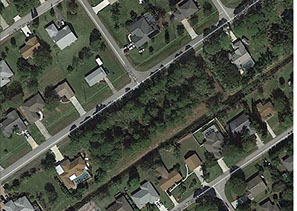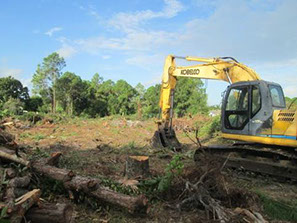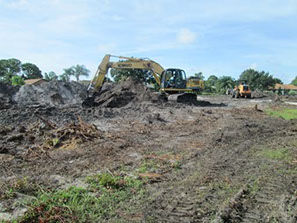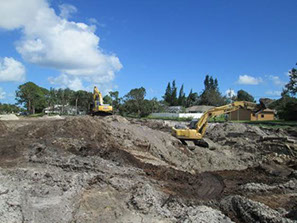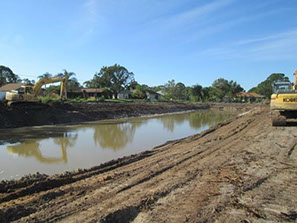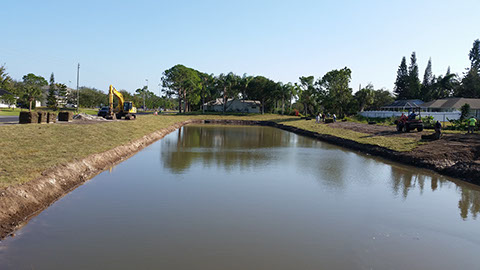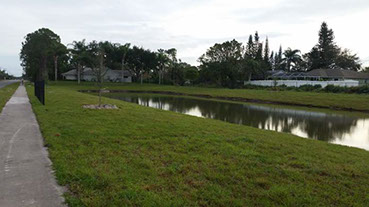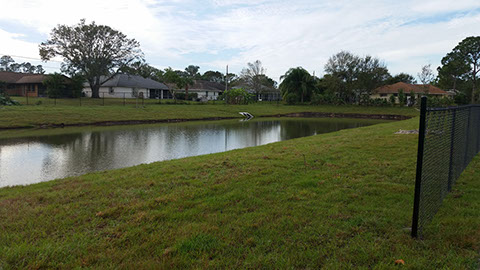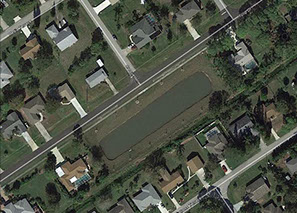Tulip Drainage Improvement Project
Completed 12/3/2016
Funded with FDEP Section 319
Retention Pond and Neighborhood Pocket Park
The project was funded in part by a Section 319 Nonpoint Source Management Program Implementation grant from the U.S. Environmental Protection Agency through an agreement/contract with the Nonpoint Source Management Section of the Florida Department of Environmental Protection.
This project is part of a Basin Management Action Plan (BMAP), which is a plan that aims to reduce nutrient loadings from stormwater runoff into the Indian River Lagoon, in Sebastian, FL. In addition to reducing nutrient loads into the Indian River Lagoon, it will reduce the amount of nutrient loadings into the Saint Sebastian River watershed. The project area is residential with recreation fields. Runoff from surrounding yards and recreation fields will be held in an on-site wet retention pond, allowing time for nutrients to be filtered out of the runoff water through percolation instead of directly flowing to impaired watersheds.
Tulip Drainage Improvement
The drainage project is basically the installation of a retention pond which has been identified in the City’s Stormwater Master Plan as a required retention basin to retain stormwater during storm events. The drainage system for the City’s central area of the Sebastian Highlands is unable to handle the flow of runoff during heavy storm events and typically several streets like Tulip Drive will flood for a short period. Due to the need to improve storm water runoff and to help improve water quality, the City received funds from FDEP Section 319 Grant to help in the construction, monitoring and education. A retention pond is a best management practice measures to help reduce storm water pollutants as well as reduce Nitrogen and Phosphorous from the City’s Stormwater system and to help improve the Indian River Lagoon. The retention pond is comprised of drainage pipes, a box structure, grassy swales and a control flap gate.
Environmental monitoring of the Tulip wet retention pond will be conducted by trained staff for the purpose of determining the reduction of pollutants within the system. Before commencement of monitoring, the City has an approved Environmental Protection Agency Quality Assurance Project Plan (QAPP). The monitoring plan will specify the sampling locations, sampling instruments, and parameters to be sampled. The parameters shall include, but are not limited to: TN (Total Nitrogen)(lbs./yr.), TP (Total Phosphorous)(lbs./yr.), Total Suspended Solids (lbs./yr.) and nitrite/ nitrate (NO2/NO3) from rainfall and runoff flow. Monitored events shall include 7 – 10 discrete rain events, generally greater than 0.20 inches and less than 1.5 inches. Monitoring is to be performed at inflow and outflow locations of the retention pond in accordance with the approved QAPP.
Engineering Department is responsible for the routine inspections and monitoring of all storm water facilities to ensure these drainage systems are well maintained and operating to avoid any flooding. City staff will investigate any citizen complaints or concerns regarding any storm water violations or illicit discharge. Any illicit discharge violations will be required to clean-up the incidents immediately or the violator will be fined for the cost of clean up and the cost of inspections.
What is a Retention Pond?
A retention pond or “basin” is used to manage stormwater runoff and to prevent flooding and down-stream erosion. These basins are designed to allow relatively large flows of stormwater to enter, but only discharges through a control structure that functions only during very large storm events. These basins also improve water quality by retaining the runoff and allowing sediments, debris and other nutrients and pollutants to settle. Retention ponds are some time called a “wet pond” or wet detention basin or stormwater management pond. It is basically an artificial lake with vegetation around the perimeter and includes a permanent pool of storm water in the design of the system. It is different from a detention pond, sometimes called a "dry pond," which will temporarily store water after a storm or rain event, but eventually empties out at a controlled rate to a downstream water body. It is also different from an infiltration pond or basin which is designed to direct Stormwater or rain water into the ground water through permeable soils.
The Tulip pond was designed for retainage, improve water quality and to enhance the area by making it a neighborhood pocket park. In addition, the City is testing and monitoring the drainage discharges to evaluate the amount of Nitrogen and Phosphorous.
City Inspections
Engineering staff will assist in educating the community regarding water quality improvement measures and to report any illicit discharges of pollutants into the storm water system. They will conduct routine site inspections to ensure proper water quality and erosion control measures are in place and functioning. Staff will also inspect storm water facilities within the public right-of way to ensure these systems are proper maintained and operating.
Link To A Brochure on the improvements: Tulip Drainage and Water Quality Improvement


Copyright (C) 2019 - City of Sebastian - Problems or Questions: contact jzingarelli@cityofsebastian.org
